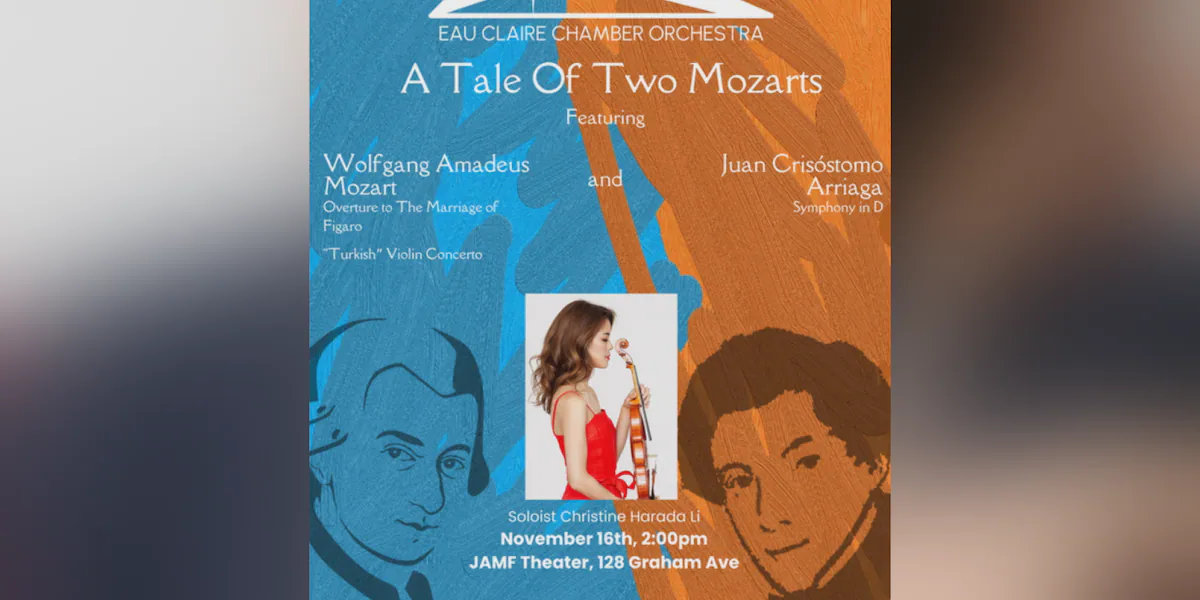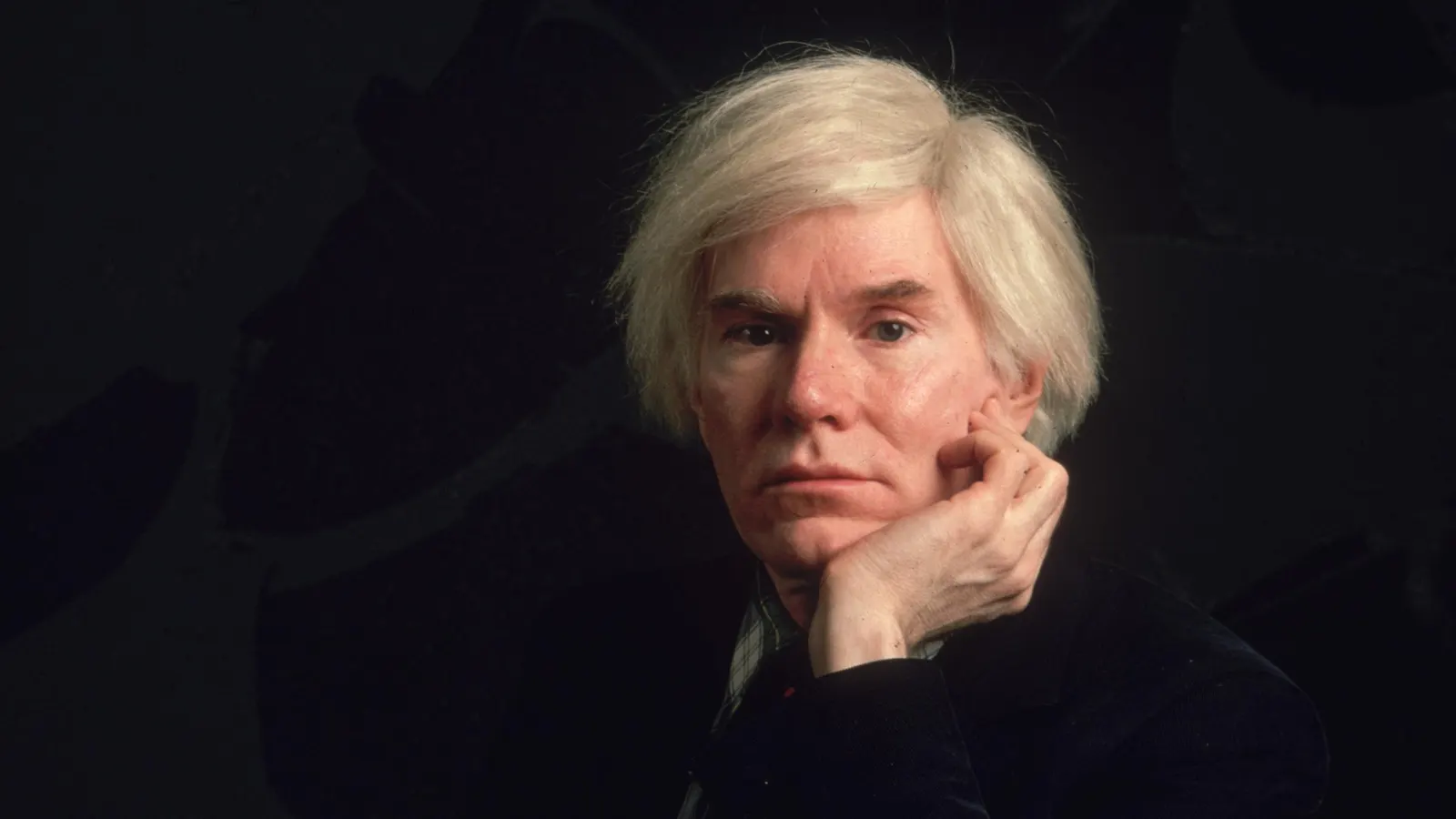Copyright WEAU

EAU CLAIRE, Wis. (WEAU) - The Eau Claire Chamber Orchestra will hold a concert at the Pablo Center, Sunday, November 16 at 2:00 p.m. News Release: The Eau Claire Chamber Orchestra, led by Dr. Matthew Poon, will present A Tale of Two Mozarts on November 16 at 2 pm in the JAMF Theater. The concert will feature Mozart’s Overture to the Marriage of Figaro and the “Turkish” violin concerto with soloist Christine Harada Li. The orchestra will also perform Symphony in D by the “Spanish Mozart” Juan Cristomo di Ariaga. Wolfgang Amadeus Mozart (1756-1791) is a name that needs no introduction. By age five he was already composing and by age six he was playing for Viennese nobles. At age eight, his father took him on a three-year tour around Europe, showcasing his talents around the continent. By age 13 he became the honorary ‘Konzertmeister’ or first violin of the Salzburg court and was learning the Italian operatic style, a prerequisite for any international composing career. While on various trips to Italy, he befriended violinist Pietro Nardini and his pupil Thomas Linley. Collaborative sessions with the two inspired him to compose more violin pieces in 1775, in the form of concertos. One of these concertos was Violin Concerto No. 5, also known as the “Turkish” concerto. The LA Philharmonic perfectly describes the grander context of this piece relating to his skill, writing that it “demonstrates great imagination in his experimentation with fluctuating tempos and diverse meters within single movements. Such freedom in his handling of material expresses not only an originality of form, but also Mozart’s knowledge and command of both the Italian and French styles.” It features three movements, starting with a quick-paced Allegro, transitions into a slower Adagio, and a conclusive Rondeau that calls back to the first movement. The concerto gets its “Turkish” nickname from its section of “Turkish music”, a musical style popular in western music loosely based on the music of Turkish military bands, during the Rondeau. By 1782, Mozart was twenty-five years old and living in Vienna. He continued to compose with the full favor of the Holy Roman Emperor, Joseph II, this time focusing on the style of Opera Buffa, or comedic Italian operas. When invited to write a buffa for the imperial theater, Mozart had his sights set on adapting The Marriage of Figaro. While the initial five act comedy written by Pierre-Augustin de Beaumarchais was banned in Austria due to political content, Mozart was allowed to score it with the help of imperial court poet Lorenzo Da Ponte who translated it into Italian… and censored many of the political themes. The Overture to The Marriage of Figaro is the most iconic effort to come from this opera: it is an upbeat, quick piece in the key of D major that acts as an introduction to the world of the opera itself. The full weight of the orchestra is used to deliver one of the most sudden and iconic hooks in classical music. The longevity of the overture has allowed it to appear in various other media like The King’s Speech, Pride and Prejudice (1995), and Willy Wonka and the Chocolate Factory. Juan Crisotomo Arriaga (1806-1826) was born January 27th 1806, in the Biscay region of Spain. After showing exceptional talent at a young age, Arriaga’s father sent him to Paris in 1821 to further his musical proficiency. Here he studied under influential composers including Francois-Joseph Fetis, the Master of the Royal Music in Belgium. Over the span of five years Arriaga composed three published string quartets, pieces of church music, and Symphony in D, which was never officially published in his lifetime. Tragically, on January 17th 1826, Arriaga passed away from a lung ailment. He was only nineteen. The piece, while labeled in the key of D, never conforms to either the minor or major variant for the whole duration. It features three Allegro sections and one Andante section in the middle. The symphony includes Basque influences, which embraces the subcultural themes of Northern Spain and Southwest France. The piece itself is seen as a major pioneer for the rise of Basque inspired music in the 19th century. While never able to amount to the legacy of other composers during the period, Arriga’s undeniable talent and influence on the nationalistic Basque style of music has nonetheless been appreciated in recent times, with him even being dubbed the nickname “The Spanish Mozart” due to a shared birthday and child prodigy upbringings. Violinist Christine Harada Li is a versatile artist with an international career as a performer, educator, and arts leader. As a performer, she has appeared in concerts across the United States, Canada, Japan, Germany, Italy, Austria, Spain, and Israel, and recently was a featured soloist with the University of Michigan Symphony Orchestra, Marquette Symphony Orchestra, and the Anchorage Youth Symphony. Passionate about chamber music, she has frequently performed with the award-winning Koinonia Trio, which was formed in 2015. As an orchestral musician, Dr. Li has had the opportunity to play with the St. Louis Symphony Orchestra, CityMusic Cleveland Chamber Orchestra, and the Ann Arbor Symphony. She has performed (both violin and viola) as a guest artist at multiple music festivals such as Maui Classical Music Festival, Oberlin Acoustics Workshop and the Ann Arbor Chamber Fest. Dr. Li has held leadership roles with art organizations, serving as Education Director at the Innsbrook Institute Summer Festival and Academy, Artistic Director and co-founder of the Anchorage Chamber Music Festival, and President of the Anchorage Fine Arts Society. Christine graduated summa cum laude with a Bachelor of Music degree from the University of Michigan, School of Music, Theater and Dance and completed her Master of Music degree at the Hochschule für Musik, Theater und Medien in Hannover, Germany. Her principal teachers here were Yehonatan Berick, Elisabeth Kufferath, Anne Röhrig (baroque), and Arthur Greene (piano). She completed her Doctorate in Musical Arts (D.M.A.) degree in 2020, studying with David Halen at the University of Michigan. You can find information about ECCO and tickets here



